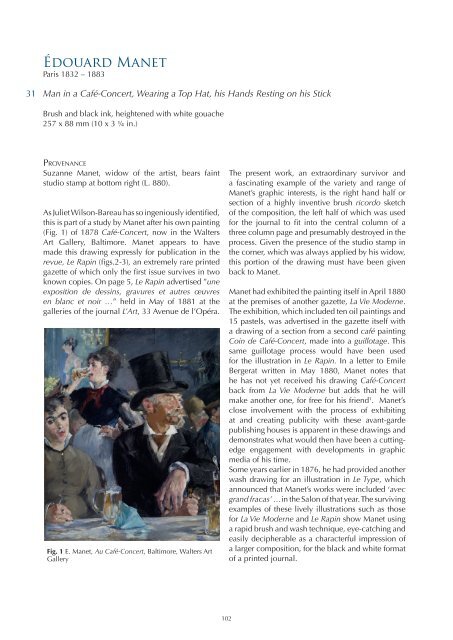XV - Works On Paper - Marty de Cambiaire (English)
Create successful ePaper yourself
Turn your PDF publications into a flip-book with our unique Google optimized e-Paper software.
Édouard Manet<br />
Paris 1832 – 1883<br />
31<br />
Man in a Café-Concert, Wearing a Top Hat, his Hands Resting on his Stick<br />
Brush and black ink, heightened with white gouache<br />
257 x 88 mm (10 x 3 ¼ in.)<br />
PROVENANCE<br />
Suzanne Manet, widow of the artist, bears faint<br />
studio stamp at bottom right (L. 880).<br />
As Juliet Wilson-Bareau has so ingeniously i<strong>de</strong>ntified,<br />
this is part of a study by Manet after his own painting<br />
(Fig. 1) of 1878 Café-Concert, now in the Walters<br />
Art Gallery, Baltimore. Manet appears to have<br />
ma<strong>de</strong> this drawing expressly for publication in the<br />
revue, Le Rapin (figs.2-3), an extremely rare printed<br />
gazette of which only the first issue survives in two<br />
known copies. <strong>On</strong> page 5, Le Rapin advertised ”une<br />
exposition <strong>de</strong> <strong>de</strong>ssins, gravures et autres œuvres<br />
en blanc et noir …” held in May of 1881 at the<br />
galleries of the journal L’Art, 33 Avenue <strong>de</strong> l’Opéra.<br />
Fig. 1 E. Manet, Au Café-Concert, Baltimore, Walters Art<br />
Gallery<br />
The present work, an extraordinary survivor and<br />
a fascinating example of the variety and range of<br />
Manet’s graphic interests, is the right hand half or<br />
section of a highly inventive brush ricordo sketch<br />
of the composition, the left half of which was used<br />
for the journal to fit into the central column of a<br />
three column page and presumably <strong>de</strong>stroyed in the<br />
process. Given the presence of the studio stamp in<br />
the corner, which was always applied by his widow,<br />
this portion of the drawing must have been given<br />
back to Manet.<br />
Manet had exhibited the painting itself in April 1880<br />
at the premises of another gazette, La Vie Mo<strong>de</strong>rne.<br />
The exhibition, which inclu<strong>de</strong>d ten oil paintings and<br />
15 pastels, was advertised in the gazette itself with<br />
a drawing of a section from a second café painting<br />
Coin <strong>de</strong> Café-Concert, ma<strong>de</strong> into a guillotage. This<br />
same guillotage process would have been used<br />
for the illustration in Le Rapin. In a letter to Emile<br />
Bergerat written in May 1880, Manet notes that<br />
he has not yet received his drawing Café-Concert<br />
back from La Vie Mo<strong>de</strong>rne but adds that he will<br />
make another one, for free for his friend 1 . Manet’s<br />
close involvement with the process of exhibiting<br />
at and creating publicity with these avant-gar<strong>de</strong><br />
publishing houses is apparent in these drawings and<br />
<strong>de</strong>monstrates what would then have been a cuttingedge<br />
engagement with <strong>de</strong>velopments in graphic<br />
media of his time.<br />
Some years earlier in 1876, he had provi<strong>de</strong>d another<br />
wash drawing for an illustration in Le Type, which<br />
announced that Manet’s works were inclu<strong>de</strong>d ‘avec<br />
grand fracas’ …in the Salon of that year. The surviving<br />
examples of these lively illustrations such as those<br />
for La Vie Mo<strong>de</strong>rne and Le Rapin show Manet using<br />
a rapid brush and wash technique, eye-catching and<br />
easily <strong>de</strong>cipherable as a characterful impression of<br />
a larger composition, for the black and white format<br />
of a printed journal.<br />
102
















